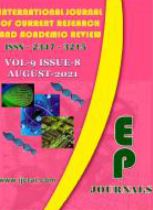Abstract Volume:9 Issue-8 Year-2021 Original Research Articles
 |
Online ISSN : 2347 - 3215 Issues : 12 per year Publisher : Excellent Publishers Email : editorijcret@gmail.com |
Bioremediation is the term used to describe biological strategies applicable to repair of damaged environment using biological factors. Microorganisms can release enzymes in soil and the enzymes have the ability to catalyze the oxidation of a variety of different hydrocarbons indicated by their broad substrate specificities. The enzyme activity of soil is the sum of the activity of al1 accumulated enzymes. The native enzyme activity is the result of many processes which lead to partial incorporation of locally produced enzymes into the soil environment. In other words these enzymes are immobilized at the surface of the soil particles. In the last few decades, highly toxic organic compounds have been synthesized and released into the environment for direct or indirect application over a long period of time. Petroleum hydrocarbons, polychlorinated biphenyls (PCBs), polycyclic aromatic hydrocarbons (PAHs), pesticides and dyes, Radionuclides and Heavy metals are some of these types of compounds. Nowadays, several bioremediation techniques have been applied for contaminated soil treatment. For instance, these remediation techniques can be carried out either on the site or out of it. According to EP on the basis of removal and transportation of wastes for treatment there are basically two methods. These are in-situ bioremediation (bioventing, bio augmentation and bio stimulation) and ex-situ bioremediation (bioslurry system bioreactor), land farming, biopiles and composting). There is different organisms participated on bioremediation proses. This are different plants species, (Ambrosia artemisifolia, Apocynum cannabinum, Brassica juncea, Helianthus annus, animals, Medicago sativa, Melastoma malabathricum, Nephrolepis exaltata, Pteridium esculentum etc.), animals, like earthworms, enchytraeids and mites, bacteria: Bacillus, Corynebacterium, Staphylococcus, Streptococcus, Shigella, alcaligenes, Acinetobacter, Escherichia, Klebsiella and Enterobacter, and fungi: Mucor, Cunninghamella, Rhizopus, and other Zygomycota, which utilize sugars and other simple soluble nutrients. These pioneer fungi grow rapidly, have a short exploitative phase, and a high competitive ability; they are generally characterized by high tolerance to environmental stresses such as the presence of pollutants, in fact, they are common in polluted soils. In general bioremediation provides a technique for cleaning up pollution by enhancing the natural biodegradation processes. Regardless of which aspect of bioremediation that is used, this technology offers an efficient and cost effective way to treat contaminated soil.
How to cite this article:
Ewnetu Teshale. 2021. A Review: Different Sources of Soil Pollutant and Bioremediations with Organisms.Int.J.Curr.Res.Aca.Rev. 9(8): 94-103doi: https://doi.org/10.20546/ijcrar.2021.908.009



Quick Navigation
- Print Article
- Full Text PDF
- How to Cite this Article
- on Google
- on Google Scholor
- Citation Alert By Google Scholar
